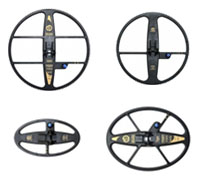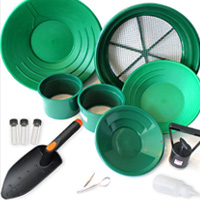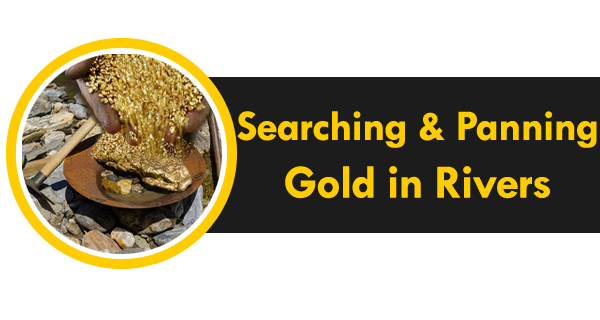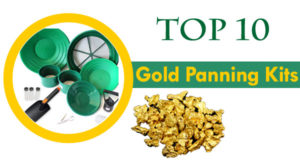If you are an outdoors person then you may well have become intrigued with the idea of panning for gold in a river.
Maybe you are looking for a big catch that will put dollars in your pocket or it could be a hobby.
Regardless, if you want to pan for gold in a river using a metal detector then you will need to be perseverance and patient.
What’s more, you also need to spend time mastering coin hunting and so it makes sense for you to test your skills in a garden before actually beginning your quest to pan for gold in a river.
Where to Find Gold in Rivers
Look Where Gold has Previously been Found
The best place to hunt for gold coins or silver or other valuable items is by looking for them in a place where such items have already been found in the past.
Typically, you need to look to use a special kind of metal detector to help you find gold in a river. The very low frequency or VLF metal detector is designed to help you find gold and is more sensitive, which is necessary when looking for small items of gold or silver.
If your budge permits then you should look for the PI (pulse induction) detector which uses the latest technology to help you find gold coins and valuable ornaments and silver. This kind of metal detector is designed to help you locate large gold nuggets.
Old Riverbeds
 Keep in mind that gold, more often than not is mined from river beds that are not only old but also extinct.
Keep in mind that gold, more often than not is mined from river beds that are not only old but also extinct.
In such places erosion can help to grind free the gold from the rock in which it is trapped and it may travel downstream. Any place where the river cuts into a piece of land is a good place to look for gold coins, silver or valuable ornaments.
Another place to pan for gold in a river is an ancient riverbed or an old river channel. When you come across an old river you can start your search for gold in a place where the gravel has been overgrown and where cottonwood trees are growing.
And if you are lucky enough to find gold, then make sure that you keep a map that shows where you found the gold.
This map may reveal a pattern and so you can scan those areas again for gold.
Useful Tools for Panning Gold in River
Use Submersible Search Coils
 Armed with a suitable metal detector you can then start your hunt for gold in a river. If you find some gold then be sure to search the nearby area for more gold.
Armed with a suitable metal detector you can then start your hunt for gold in a river. If you find some gold then be sure to search the nearby area for more gold.
When searching for gold in a river makes sure that you make use of a search coil that can be submerged in the water.
Also, make sure that you scan over the bottom of the stream and keep looking slowly in the search area.
From time to time, you will need to vary your operating heights, especially if you hear a lot of chatter.
Gold Pan and Shovel
 Besides your metal detector you will also need to equip yourself with a plastic gold pan as well as a suitable shovel. The shovel will help you loosen rocks as well as gravel. As soon as your metal detector shows you that it has found a metallic object, you should scoop that into your pan.
Besides your metal detector you will also need to equip yourself with a plastic gold pan as well as a suitable shovel. The shovel will help you loosen rocks as well as gravel. As soon as your metal detector shows you that it has found a metallic object, you should scoop that into your pan.
Next, test the materials found in the pan with your detector to see whether or not the material is gold or silver or some valuable ornaments. In case you did not discover any gold then simply return the material back into the river and try again.
Keep on trying till the detector shows you that it has discovered metallic objects.
Recommended Read: Top 6 Best Gold Panning Kits
Here is how you can Pan For Gold in a River
Step 1
Take a gravel sample and fill it to about seventy-five percent of your gold pan. Once you become adept at this, you can easily start filling the pan all the way to the top. Be sure to remove the larger pieces of rocks so that there is more small material and gold left in the pan.
Step 2
Choose a suitable spot to pan for gold in a river. Ideally, it makes sense to pan for gold in water that is not less than 6 inches deep and where the water flows fast enough to sweep the silty water away from the pan. This allows you to see what you are doing.
Step 3
Take the pan and submerge it into the river at a suitable location in the river.
Step 4
With your fingers kneading the contents of the pan you must separate the clay and dirt as well as other unwanted materials. In the end, make sure that only broken up materials are left in the pan. Be sure to keep the pan submerged in water when separating the unwanted materials. Don’t worry about losing gold because gold being heavy will sink to the bottom of the pan.
Step 5
Once the materials in the pan are completely broken up, take the pan and shake it up with a strong left to right motion while also making sure that the pan remains submerged in the water.
This helps in breaking up the contents of the pan further and it also helps to push heavy materials down into the bottom of the pan. Just make sure that you don’t use too vigorous a motion as that can cause the gold to spill over the pan.
Step 6
As you shake the contents of the pan the rocks will come up to the surface. Sweep these rocks out of the pan. The gold will not be lost because the light rocks will ensure that the gold stays at the bottom of the pan.
Step 7
Repeat step-6 four to five times, unless all the rocks and pebbles are gone.
Step 8
Tilt your pan down and in this position – shake it to and fro in the left to right direction. Just do not allow any material to spill over when shaking the pan. The gold will then work down towards the edge of the pan.
Step 9
Now, in a very careful manner you need to make round motions to allow the water to spill out over light and worthless materials in the pan.
Step 10
Use a magnet to take out the magnetic black colored sand from the bottom of the pan. Be extra careful when doing this as even though gold is not magnetic it can get trapped in the magnetic materials and so can be accidentally removed.
Now, safely remove the gold with the help of a pair of tweezers.
Here is a video showing How to Pan for Gold




Be First to Comment